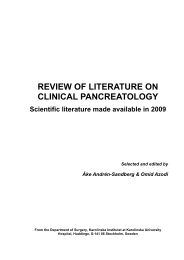Download PDF - The Pancreapedia
Download PDF - The Pancreapedia
Download PDF - The Pancreapedia
Create successful ePaper yourself
Turn your PDF publications into a flip-book with our unique Google optimized e-Paper software.
through the common duct into the gut. By the 13 th<br />
day the pancreas is "greatly branched," and by<br />
the 15 th day it is still "diffusely spread" in the<br />
mesentery 93 .<br />
We studied 95 the growth pattern of the hamster<br />
pancreas by examining fetuses and newborns<br />
immediately after birth and for two to four weeks<br />
afterward by histology, immunohistochemistry<br />
and, in part, by scanning electron microscopy<br />
(SEM). Our observations, which are in line with<br />
those in other species, including humans,<br />
indicated the development of endocrine cells from<br />
the pancreatic tubules. Glucagon cells were found<br />
to be the first endocrine cells identifiable in the<br />
budding of the primitive pancreas from the<br />
duodenum at around the 11th day of the<br />
gestation. Even at this early stage, single or a few<br />
glucagon cells could be demonstrated within the<br />
undifferentiated cells 96-98 . At the later stages<br />
(during the 12th and 13th day of gestation), single<br />
or a small group of glucagon cells appear,<br />
distributed along the length of the primitive<br />
branches (Fig. 8). During 13th to 15th day of<br />
gestation, a tubular structure with primitive cells<br />
extended along the greater curvature of the<br />
stomach attached by intserstitium to the primitive<br />
spleen. As the spleen moves to the left side of the<br />
abdomen, it pulls the pancreas with it. At this<br />
stage, scattered α-cells but none or only a few βcells<br />
(cells immunoreactive to anti-insulin<br />
antibody) could be visualized. A small cell<br />
conglomerate of β-cells appeared one day before<br />
birth (day 15 or 16 of gestation). We could not<br />
detect any δ-cells before birth. In a 1.3-g fetus,<br />
the pancreas was already differentiated. <strong>The</strong> fetal<br />
pancreas seems to release an insulin-like<br />
substance, however, islets of Langerhans could<br />
not be seen in the neonatal hamster’s pancreas<br />
neither in our study nor in that of Sak et al. 94<br />
According to these investigators, aldehyde fuchsin<br />
positive granulation could first be observed in the<br />
hamster’s pancreas one hour after birth, which<br />
are found either singly or in scattered, irregular<br />
nests of three to four cells. At day 13, a large<br />
number of the glucagon cells contrasts with the<br />
relatively small number of somatostatin cells and<br />
14<br />
a few, if any, insulin cells. At day 14 of gestation<br />
(a day before birth) cells immunoreactive with<br />
anti-somatostatin and anti-insulin appear and their<br />
increased number correlated with the decreased<br />
number of the glucagon cells (Fig. 8). This<br />
reverse relationship between the number of the<br />
glucagon and insulin cells would indicate a shift in<br />
the synthetic pathway of hormones (from<br />
glucagon to insulin) within the same cells rather<br />
than the generation of these two cell types from<br />
the stem cells. In fact, the presence of two<br />
different hormones within the same cell has also<br />
been found in the embryonic human pancreas 96,<br />
99 . <strong>The</strong>se findings strongly suggest that, even<br />
during the embryonic development, the mature<br />
cells have potential to shift their differentiation<br />
from one mature cell type to another.<br />
Discrete small islets were still relatively rare in<br />
two-week-old hamsters. <strong>The</strong>reafter, islets grew<br />
rapidly for the next two weeks. In fact, islet size<br />
almost doubled to 87.4 ± 28.44 mm and continued<br />
to increase in size with age.<br />
Unlike the islets, acini were recognizable one day<br />
before birth in clusters, buds, and rows that<br />
formed glandular structures with tiny lumens (Fig.<br />
8f). <strong>The</strong>y reached their final size (37.61 ± 12.42 X<br />
26 / 66 ± 6.85 mm) between two and four weeks<br />
after birth and did not show, in contrast to islets,<br />
any size variations by age. Also, the structures of<br />
centroacinar cells, ductules, and ducts were<br />
recognizable in the fetus shortly before birth.<br />
Epithelial cells were ill defined in the small ducts.<br />
Otherwise, their structures did not differ from<br />
those in adults. <strong>The</strong> scanning electron<br />
microscopic findings of the fetal pancreas are<br />
illustrated in Figures 9 and 10.<br />
4b. Cellular and Sub-cellular Anatomy of the<br />
Pancreas<br />
<strong>The</strong> presence of a variety of exocrine and<br />
endocrine cells in the pancreas has hampered our<br />
understanding of the function of each individual<br />
cell component and especially their interaction.<br />
Recent investigations point to a complex dialogue<br />
between the individual exocrine cells on the one<br />
hand, between the endocrine cells a well as












